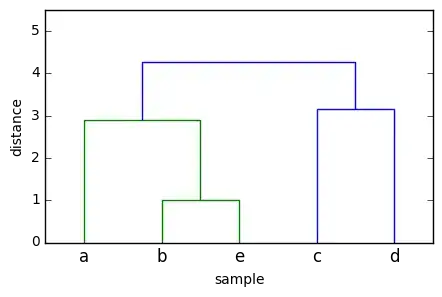For an assignment, I have used iPython to create the dendrogram below, using Ward's method and Euclidean distance, from the following data:
$$a=(0,0)$$
$$b=(1,2)$$
$$c=(3,4)$$
$$d=(4,1)$$
$$e=(2,2)$$
 where dist({a},{b,e}) = 2.88, and dist({a,b,e},{c,d})=4.27.
where dist({a},{b,e}) = 2.88, and dist({a,b,e},{c,d})=4.27.
How are these values derived? I've tried using the recursive method given here, but am not getting the same results.
Any help muchos appreciated.
I know that dist(a,b)=$\sqrt{5}$, dist(a,e)=$\sqrt{8}$, so using the formula on the wikipedia page, I have dist({a},{b,e})=$\frac{2}{3}\sqrt{5} + \frac{2}{3}\sqrt{8} - \frac{1}{3} = 3.04$. Where am I going wrong?